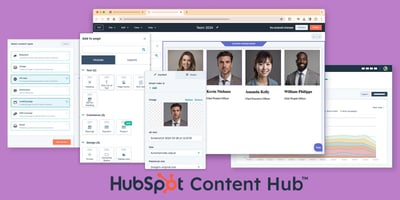HubSpot portals serve as a central Hub for managing sales, customer service, marketing and operations all in one place. HubSpot portals empower businesses to streamline processes, automate mundane tasks, and gather valuable customer data and insights.
As a business grows and the longer you use HubSpot the more cluttered and outdated it can become which can often lead to inefficiencies, missed opportunities and irrelevant data. Furthermore, HubSpot is continuously making updates and bringing out new tools that you may not even be aware of and therefore you are not getting the most value out of your portal.
What is a HubSpot portal audit?
A HubSpot portal audit is a comprehensive review of your HubSpot portal to outline how well it is set up, maintained and used within your organisation. This includes looking into your portal's technical configuration and how effectively your team is using the tools and features that you are paying for each month. The portal audit commonly covers multiple key areas such as:
- Configuration: Portal set up (all the portal settings and connections), pipelines, properties, deal stages, ticket stages, automations and integrations.
- Data check: duplicate data, marketing contact tier management (unsubscribes, unengages and hard bounces), invalid email addresses, quarantined email addresses and properties (unused and duplicates).
- User adoption: use of all the tools and features within your plan to ensure you are maximising your subscription, ways to improve and optimise including opportunities to start using the tools that are not being used including identification of potential training and knowledge gaps.
A HubSpot portal audit acts as a health check to optimise your portal's performance and identify new opportunities with the goal of improving user efficiency and maximise your ROI from the portal.
Why regular portal audits matter
Regular audits of your HubSpot portal audit are essential to maintaining a clean, efficient and high performing CRM. As time passes, contacts can become outdated, properties become unused and workflows start overlapping. As a result productivity and reporting will be negatively affected.
Key benefits of regular audits:
- Improved data accuracy
- Enhanced user experience
- Optimised automations
- Better reporting & insights
- Reduced risk
HubSpot portal audit process
Understand the portal
Start by clarifying what subscription the portal has and what that subscription offers from a features perspective.
Review CRM data and properties
Assess the quality and structure of your data. This includes checking for outdated records, duplicates, invalid email addresses, inconsistencies across contacts, companies and deals. Review the properties in your portal, determine if there are any unused properties or duplicates and if they are clearly named, used correctly and still relevant to your processes.
Evaluate pipelines & stage
If you have Service or Sales Hub this will apply to you, check that your pipelines and stages accurately reflect your team’s processes. Ensure that your pipelines are up to date, logically ordered and named clearly. Review your automations to ensure that all automations tied to each stage are still working and if there are any further optimisations you can implement to make your portal easier to use.
Tools and features
Determine what tools and features are available to you in your subscription, this gives you the opportunity to ensure that you are using your portal to the fullest. Make a list of all the tools and features you are not making use of to identify how you can incorporate them to elevate your strategy.
Inspect workflows
Start by reviewing all your active and inactive workflows to determine if they still serve a purpose. Look out for outdated logic, broken triggers, or workflows that overlap or counteract each other. HubSpot also shows you which workflows need review, it is recommended to review and fix those immediately to avoid long term damage to your data and processes. Once again, it’s always worth checking that everything is clearly named and grouped logically in folders.
Assess integrations and connected apps
Over time it’s common for integrations and connected apps to become outdated or unused. Review all your apps in your portal and evaluate whether they are actively used, properly configured and still aligned with your business goals. Often we find there is a sync issue in the integrations or that the integration is no longer necessary, these need to be flagged for removal or reconfiguration.
Analyse dashboards and reporting
Review your dashboards and reports to ensure they align with your key performance indicators and whether they are being used by the team for data driven decisions. We often recommend creating a data check dashboard that monitors the quality of your data and brings up my records that have issues.
Review user access and permissions
Access is critical but often overlooked within businesses. Make sure that each user has the right level of access based on their role and responsibilities, and remove any inactive and unnecessary user accounts.
Findings and next steps
Once you have conducted your audit you should have a list of action items, this includes a list of fixes/enhancements you need to make to your portal and a list of opportunities which should include the tools and features you have access to but do not make use of. From there you can work through those lists based on the priority of each item.
How often should you conduct an audit
Best practice says businesses should conduct a HubSpot portal audit at least twice a year to keep the system clean, efficient and aligned with evolving goals. However, the ideal frequency can vary depending on your company size, the complexity of your setup and how actively your team uses the platform.
For organisations that heavily rely on HubSpot across marketing, sales and service, quarterly audits are recommended to stay ahead. Smaller businesses with a more stable setup may be able to get away with once a year.
Based on personal experience there are clients that work within HubSpot all day everyday and those are the portals we audit every single month at a high level and then a big audit once a quarter. Auditing the portals at a high level every month also allows us to keep up to date with HubSpots constant updates and product launches, ensuring if there are any new tools available to our clients that we are able to bring it to their attention immediately, initiate training and implement the tools into our strategies.
Final thoughts
A well maintained portal is more than just a tidy backend, it’s the foundation for efficient, insight-driven and scalable business operations. As your business evolves and HubSpot continues to release new tools and features, regular portal audits ensure you’re keeping up the pace and getting the full value from your investment.
Whether you’re uncovering broken workflows, cleaning up inaccurate data, or discovering underutilised tools, an audit provides clarity and direction. It helps you align your CRM with your business goals, boosts user adoption, and uncovers hidden opportunities to enhance your marketing, sales and service efforts.
At the end of the day, HubSpot isn’t a set and forget platform, it needs to be managed in order for it to be the dynamic and powerful tool that it is.





